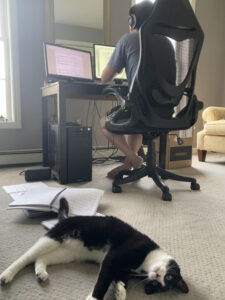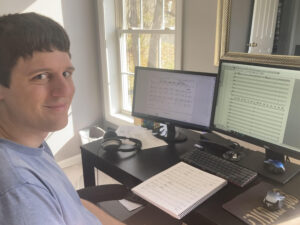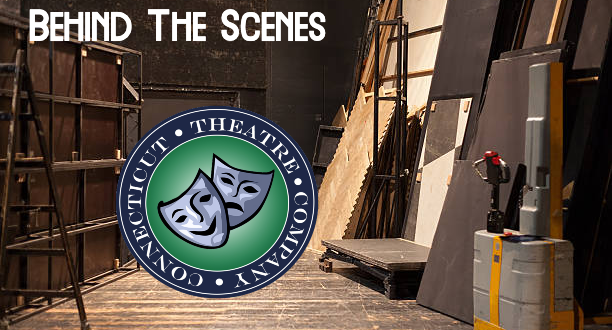Behind The Scenes: Resident Music Director Nick Stanford

Behind the Scenes
Nine: The Music
By Becky McLean and Nick Stanford
As Connecticut Theatre Company gets ready to mount their upcoming production of Nine, a musical centered on the life of Guido Contini—an Italian filmmaker facing a midlife crisis—and the women who have influenced him, we are offering a peek behind the curtain of this artistically ambitious work.
First up in this series, we have Nick Stanford, Resident Music Director of Connecticut Theatre Company and his current massive undertaking: reduce an orchestration meant for 23 players down to himself and seven others.
As Nick’s fiancé, I am granted a rarified view into this process which I find absolutely fascinating. Nick is quick to retort that his score reductions are in fact extremely boring and not fun to watch. Perhaps it’s true that observing Nick toil at his computer as he meticulously enters the score note by note is not gripping. Yet nonetheless, there is something inherently thrilling about any creative process. Perhaps it is the looming deadline of the first tech rehearsal with the band that has me on the edge of my seat. Seeing Nick calculate how many hours a day he must work on the scores makes it feel like there is a perpetual countdown clock running in the background. But more so than the time constraint, I think what strikes me about reducing scores are the choices that must be made in order to preserve the author’s intent and artistry: a hard feat to do when you have limitations on your instruments and number of players.
When I tell people that Nick is working on score reductions, they are curious to know what that entails because it is not something one ordinarily encounters in their daily life. After toying with the idea, I have scrapped plans for a Making-of documentary… it would have been just a lot of shots of Nick on his computer. Instead, I’ll blog about my fly-on-the-the wall perspective and when Nick needs a break from the song he is currently working on (“Be Italian”), he can share his musical insights more in depth.
 Nick Stanford with his Music Supervisor
Nick Stanford with his Music Supervisor
The score reducing process
The first thing about reducing scores is choosing the instruments carefully. The licensed books for Nine include five reeds, two French horns, two trumpets, two trombones, one harp, one keyboard, three violins, two violas, two cellos, one bass, and two percussionists. Due to space and budget constraints, Nick can only get away with eight players for this production. He first listened through the cast recording of Nine to try to understand the effect that each instrument has on individual songs as well as the overall sound of the original production and how it supports the story being told.
When building a pit, one typically starts with the rhythm section. The usual non-negotiable is the trifecta of piano, bass, and drums. But here, Nick is making an interesting choice. He really wants to lean into the Italian-feel of this score and is building his sound around the string section with other instruments to add ‘color’ and support. So, with that in mind, he builds a core with two violins, one viola, one cello, one bass, and his keyboard—which will be played using a harp patch for most of the show to add an ethereal effect. This brings our running total up to six. He then adds a reed and combined trumpet/French horn book, which rounds out spots seven and eight. This unfortunately eliminates the percussion book by default—but luckily Nick thinks he can get away with it by being creative. More on that in a bit.
The next step in the process is the most arduous: entering every note of the eight instrument books for every song into a music program called Finale. In other shows Nick has reduced, he can usually get by with only needing to enter some parts into Finale. For instance, in A Christmas Carol in 2022, Nick had to reduce four reed parts into two. He put in all four reed parts into the program and then pieced together two new reed books with just the essentials. The rest of the instrument parts were easier to eliminate or write into the existing scores by hand, a huge time savings. Easier yet was a recent production of Anything Goes that Nick Music Directed where there were instructions on how to build your pit depending on the number of players, and the corresponding instrument books lent themselves to needing no reductions.
But in the case of Nine, with this extremely stripped back pit and string-quartet driven instrumentation, Nick is worried that the end product will not have a sufficient level of quality unless he manually adjusts all eight parts. Just as every line of dialogue is needed to tell the story and adhere to the author’s vision, a specific trumpet line might be needed to convey a sense of grandeur, or a violin line might be needed to reinforce a thematic element. So, although it’s a laborious process, this attention to detail will help ensure the entirety of the pit is cohesive, efficient, and that no essential musical moment is lost.
After typing in each instrument line for a song, Nick will play back and listen to the raw material to evaluate how much adjusting they will need.
Making the most of what you’ve got
Reducing some songs are straight forward. Others, such as “Folies Bergères,” need a heavy hand and more hours of attention than he planned. For instance, in the middle of the song, the woodwinds are supposed to give a peppy effect as they each oscillate between two notes of a chord. One of these reed parts in insolation, though, sounds disappointingly thin and empty. As a listener you can tell it’s supposed to be more than what it is. Nick works to give the part more life while respecting the original oscillatory effect by writing arpeggios with overall arcing shapes through the phrases, but still also going up then down every other note. This is more interesting to listen to both because we hear more of the chord spelled out and because the line is far less repetitive and predictable. The line starts on a flute, but Nick moves it to piccolo later in the song to lend even more heightened excitement in what is almost a European march. And what is a march without drums? Difficult. Reaching the climax of a march without percussion is not easy. Much more layering and motion has been added in the last 20 seconds to give the song the ending it deserves.
I am getting a crash course in composition as I hang out with Nick during the entirety of this process. He turned to me the other day to show me some measures he was working on in “Claudia,” the underscoring that plays as we are introduced to her character. He asked me if it reminded me of anything I’ve seen before. I knew what he was getting at. He had explained what a ‘brass pyramid’ was when he was working on A Christmas Carol. This time however it is with strings. The concept is the same. The lowest instrument in the group starts and sustains a note, and gradually more instruments are layered in over the next few measures to build a pyramid of sound. These are typically used in significant moments in a show, so building an 11-note string pyramid with only 5 players is risky: insufficient support can weaken the effect as the ear potentially forgets some pitches. Nick’s solution is to start having not only the top voice, but also one or two inner voices, arpeggiate up the chord halfway through the progression, keeping all of the notes fresh enough to trick our ears into thinking we hear everything at once. This helps to create growth and simulates the feeling of a sound pyramid with fewer players.
How do you solve a problem like Maria? And by Maria, I mean, no percussion

As with “Folies Bergères,” Nick has been dealing with the lack of percussion in other areas of the show. In the song “Only With You,” the use of triangle can be heard predominately throughout the cast recording, giving the song a strong beat and a light feel without the use of a heavy drum kit. Nick’s version will still achieve the light and breezy tone of the song by utilizing a pizzicato cello line, syncopated flute counter melodies, and harp in the same rhythm as the flute to provide the flush out rich lost from the four missing reed books. Other times, the music simply craves percussion. In the scene change music “Samba di Guido,” audiences will be able to hear Nick’s keyboard on the woodblock and cowbell because, as you guessed, it needed [more] cowbell… to add rhythm, texture, and remain in the style of the piece. And how could we have the triumphant end of “Guido’s Song” without timpani? Nick will just layer that into a keyboard patch for his left pinky finger, no problem.
An even more challenging endeavor however comes in the jazzy and seductive number, “A Call From the Vatican.” The swing feel typically comes from the ride cymbal, so Nick re-writing the left hand of his piano part to cover it. He can afford to do that since the walking bass line is identical to what his left hand would have otherwise been playing. Still, the song struggles to grow without acoustic percussion. Most of the song is written purely in block chord quarter notes, not the most interesting rhythm. To compensate, Nick has written a new trumpet counter melody toward the end to squarely cement the song as a jazz piece highlighting how forward the character Carla is.
How will it all play out?
I find the process of score reduction to be too interesting not to share because it has certainly deepened my appreciation of music, and I think it will resonate with our patrons. Yet, I don’t think Nick’s goal is to have audience members walk away from the show thinking, “Wow, I like how Nick moved pitches to simulate a pyramid of sound.” I think Nick’s aim is to make everything feel so cohesive and deliberate that it doesn’t sound like any work went into at all. If the music supports the actors and the narrative, it will be a job well done.
Come see (and hear) for yourself if Nick gets his reductions done on time! Knowing him, they will be, and done to perfection—albeit, hot off the printer on the way to the first tech rehearsal with the band. Luckily, the other instrumentalists are all skilled enough to learn quickly and intuitive enough to fill in any details Nick may not have had time to write onto the page, such as dynamics, articulation, and phrasing.
Thanks for reading, and stay tuned to learn more from the Creative Team at Nine as they share more about the behind the scenes work that goes into what you will see on the stage this May!
Nine runs May 17th– June 2nd at Connecticut Theatre Company in New Britain. Tickets and details found at: https://www.connecticuttheatrecompany.org/nine/
Consider supporting more creative works like this by donating today!

